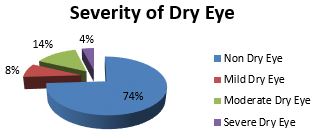Clinical Profile of Dry Eye in a Tertiary Care Hospital of Central India
Abstract
Introduction- Dry eye is a multifactorial disease of the tear film and ocular surface that results in symptoms of discomfort, visual disturbance and tears film instability with potential damage to the ocular surface. Dry eye disease is differentiated from other ocular disease and subcategorized in to aqueous deficient and evaporative dry eye disease. Dry eye disease is a frequent cause of ocular irritation that leads the patients to seek ophthalmic care. Staring at a computer monitor or digital displays for hours on end has become a part of modern workday and inevitably all of that staring can put a real strain on our eyes.
Material and Methods- This Study was conducted in the department of ophthalmology, BRLSABVM Medical College, Rajnandgaon (CG), India during study period Oct 2018 to Sep 2020. 1623 patients presenting with ocular surface symptoms over a period of 2 year were included in the study. Patients above the age of 20 year having symptoms of irritation, tearing, burning, stinging, Foreign body sensation, mild itching, photophobia, blurry vision, redness, increased frequency of blinking for one month duration were included. Patients who had suffered from corneal or conjunctival infections, contact lens users and those who had undergone extra ocular or intraocular surgery were excluded from the study. Data was compiled in MS excel and checked for its completeness and correctness. Then it was analyzed by using suitable statistical software package.
Results-In this study, 1623 patients presenting with ocular surface symptoms were taken who were administered the O.S.D.I questionnaire. The prevalence of dry eye disease in our study is 26% (422). Dry eye was most prevalent among 20-40 yrs of age with mean age of 32 yrs. In present study the prevalence of dry eye was more in male gender than female. Occupation having regular computer use was more predisposed to develop dry eye disease. In present study the most common ocular morbidity associated with dry eye disease is Meibominitis.
Conclusion- Increasing prevalence of dry eye cases in younger age group is attributed to increased use of computer & other visual display terminal like laptops, Smartphone& tablets etc by these age groups.
Downloads
References
2. Craigjp, Nichols kk,AKPeKEKetal,TFOS DEWS11 definition and classification report. Ocul Surf.2017,15(3)276-283
3. Bron Aj, PaivaCS , ChauhanSKetal,TFOS DEWS11 Pathophysiology report, Ocul. Surf.2017,15(3):438-510
4. Uchino M, Uchino y, Dogru M, Kawashima M,Yokoi N, Komuro Aetal. Dry eye disease and work productivity loss in visual display terminal user: the Osaka Study Am J ophthalmol. 2014;157(2);294-300
5. Miljanovic B, Dana R, Sullivan DA,Schaumberg DA, Impact of dry eye syndrome on vision related quality of life. AmJophthalmol 2007;143(30): 409-15
6. GuptaN, Prasad I,Jain R,D Souza P,Estimating the prevalence of dry eye among Indian Patients attending a tertiary ophthalmology clinic. Ann Trop Med Parasitol 2010;104:247-55
7. Shah S, JaniH Prevalence and associated factors of dry eye: Our experience in patients above 40 yrs of age at a tertiary care centre oman J ophthalmol 2015;8;151-6
8. 2007 Report of the International Dry eye Workshop(DEWS)ocul.surf 2007,5:65-199
9. Shimmura S, ShimazakiJ,Tsubota k, Result of a population based questionnaire on the symptoms and life styles associated with dry eye cornea 1999,18;408-11
10. SahaiA, Malik P.Dry eye; Prevalence and attributable risk factors in a hospital based population.Indian J ophthalmol 2005;53: 87-91
11. Rege A, Kulkarni v,Puthran N, Khandgave T A Clinical study of subtype.based prevalence of dry eye. J clin Diagn Res 2013;7:2207
12. Uchino M, Yokoi N ,UchinoY,DogruM,Kawashima M,Komuro A,etal Prevalence of dry eye disease and its risk factors in visual display terminal users: The Osaka study Am J ophthalmol 2013, 156:759-66
13. Schein OD,Tielsch JM, Munoz B , Bandeen-Roche K, West S Relation between signs and symptoms of dry eye in the elderly. A Population based perspective ophthalmology 1997;104:1395-401
14. Lee JB,Kim SH, Lee SC,etal. Blue light induced oxidative stress in human corneal epithelial cells:protective effects of ethanol extracts of various medicinal plant mixtures.Invest Ophthalmol Vis Sci 2014;55(7):4119-27.
15. Jie Y,XuL,WuYY, Jonas JB. Prevalence of dry eye among adult Chinese in the Beijing eye study.Eye( Lond)2009;23:688-93

Copyright (c) 2021 Author (s). Published by Siddharth Health Research and Social Welfare Society

This work is licensed under a Creative Commons Attribution 4.0 International License.


 OAI - Open Archives Initiative
OAI - Open Archives Initiative



















 Therapoid
Therapoid

